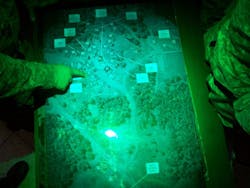Tactical Digital Hologram technology brings 3D to US Special Forces
Orlando, FL--More than 10,000 Tactical Digital Hologram units—which at first glance look like flat plastic maps—have been provided to Special Forces in Iraq and Afghanistan by the Army Research Laboratory's Simulation and Training Technology Center (STTC). The Tactical Digital Holograms allow soldiers to go from looking at the outside of a building to seeing the internal workings of its electrical system simply by walking around a display case, thanks to three-dimensional (3D) holographic technology.
The STTC is investing in commercially available 3D holographic technology by evaluating and comparing 3D holographic static images against conventional topographic data that troops currently rely on for planning and mission rehearsal. "Although the Army has been fielding these images for about the past five years, no substantiating data existed to support their utility except for anecdotal feedback like 'this is great' or 'this really helps me' from the warfighter," said H. Michelle Kalphat, STTC chief engineer. A study she co-authored with an Air Force Research Laboratory expert in 2009 showed that the appropriate use of 3D holographic imagery improves training, mission rehearsal and mission operational effectiveness.
Detailed images created from dozens of intelligence sources are laser inscribed on special film to make digital holograms. A version of this technology called "channeled holograms" allows commanders to peer at, around, over and even under fixed objects in theater, like tall buildings, raised monuments and vehicles, seeing points of interest four layers deep. The holographic images are durable and can be rolled up or cut to any size. Images are typically produced from Light Detection and Ranging (LIDAR)/Buckeye data and the images are full parallax, meaning no special viewing equipment—such as 3D glasses—are needed. Just a single, direct light source such as a light-emitting diode (LED) or the sun is needed to hit the image at a 90-degree angle to illuminate the 3D effects.
The images are not distorted when viewed under night vision goggles. The holograms permit simultaneous viewing for up to 20 participants and are interactive, allowing images to be frozen, rotated, and zoomed up to the resolution limit of the data.
SOURCE: US Army; www.army.mil/article/62149/Into_the_deep__3_D_holographic_technology_provides_detailed_human_intelligence/
About the Author

Gail Overton
Senior Editor (2004-2020)
Gail has more than 30 years of engineering, marketing, product management, and editorial experience in the photonics and optical communications industry. Before joining the staff at Laser Focus World in 2004, she held many product management and product marketing roles in the fiber-optics industry, most notably at Hughes (El Segundo, CA), GTE Labs (Waltham, MA), Corning (Corning, NY), Photon Kinetics (Beaverton, OR), and Newport Corporation (Irvine, CA). During her marketing career, Gail published articles in WDM Solutions and Sensors magazine and traveled internationally to conduct product and sales training. Gail received her BS degree in physics, with an emphasis in optics, from San Diego State University in San Diego, CA in May 1986.
